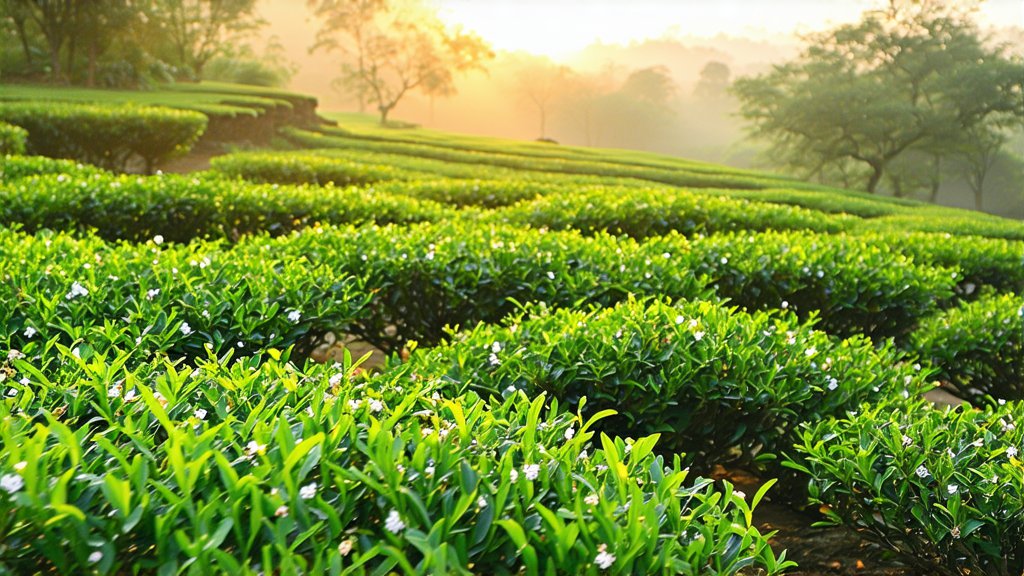
In the vast and diverse landscape of Chinese tea culture, Bai Mudan (白牡丹), or White Peony, stands as a testament to simplicity and elegance. This variety of white tea, originating from the mountainous regions of Fujian Province, has captivated tea enthusiasts worldwide with its delicate flavor profile and minimalist processing methods. As we embark on this journey through the history, cultivation, production, and appreciation of Bai Mudan, prepare to immerse yourself in the world of one of China's most cherished tea treasures.
Historical Roots and Cultural Significance
The origins of Bai Mudan can be traced back to the early Qing Dynasty, around the late 18th century. It is said that the tea was discovered accidentally when tea farmers observed sprouts covered with fine white hairs, resembling the petals of a peony flower, hence the name "Bai Mudan." This serendipitous find marked the beginning of a new era in tea production, one that celebrated the natural beauty and purity of the leaf.
Throughout history, Bai Mudan has been associated with nobility and refinement. Its subtle sweetness and gentle aroma were considered fitting for imperial courts and high-ranking officials, symbolizing purity, elegance, and sophistication. Today, it continues to hold a prestigious position among tea connoisseurs who seek not just a beverage but an experience steeped in tradition and cultural heritage.
Varieties of Bai Mudan
While Bai Mudan is primarily grown in Fujian Province, particularly in the counties of Fuding and Zhenghe, there are subtle variations within this category based on elevation, terroir, and specific processing techniques employed by different tea masters. These variations contribute to a spectrum of flavors and aromas, each offering a unique interpretation of this classic white tea.
One notable sub-variety is Gao Shan Bai Mudan, which translates to "High Mountain White Peony." Grown at altitudes above 600 meters, these teas benefit from cooler temperatures and increased humidity, resulting in a more complex flavor profile with pronounced floral and fruity notes. Another variation, Shui Xian Bai Mudan, features leaves picked from the Shui Xian tea plant, known for its robust character and ability to withstand longer infusion times without bitterness.
The Art of Processing: Minimalism at Its Best
The magic of Bai Mudan lies not only in its ingredients but also in the meticulous yet minimal processing it undergoes. Unlike other teas that require extensive shaping and oxidation, Bai Mudan is left to dry naturally under the sun or in well-ventilated rooms, preserving its inherent qualities.
-
Plucking: The process begins with careful handpicking of young shoots and leaves, typically consisting of one bud accompanied by two newly sprouted leaves. This ensures optimal levels of tenderness and flavor concentration.
-
Withering: The freshly plucked leaves are spread thinly on bamboo mats or trays and left to wither under the sun or indoors, allowing moisture to evaporate gradually. During this stage, enzymes within the leaves initiate a mild oxidation process, enhancing the tea's aroma and taste.
-
Drying: Once the desired level of withering is achieved, the leaves undergo further drying to reduce moisture content to below 5%, ensuring longevity and stability. This step may involve low-temperature baking or continued air drying, depending on traditional practices or modern adaptations.
-
Sorting and Packaging: Finally, the dried leaves are sorted by size and quality before being packaged in airtight containers to protect them from light, moisture, and odors until they reach consumers.
Appreciating Bai Mudan: A Sensory Journey
To truly appreciate Bai Mudan, one must engage all senses in a mindful ritual that celebrates its nuances. Here's a guide to savoring this exquisite tea:
-
Preparation: Use a transparent glass or Gaiwan (a traditional Chinese teapot) to observe the unfurling leaves. Rinse the vessel with hot water to warm it up.
-
Water Temperature: Heat water to approximately 80-85°C (175-185°F). Avoid boiling water as it can scald the delicate leaves, releasing bitter tannins.
-
Infusion Time: Add about 3-5 grams of Bai Mudan per 150 ml of water. The first infusion should be short, around 15-30 seconds, to awaken the leaves. Subsequent infusions can be gradually extended, typically by 10-15 seconds each time.
-
Observe: Watch as the pale yellow-green liquor reveals itself, carrying subtle hints of silver from the downy buds. Notice how the leaves dance gracefully, revealing their full beauty.
-
Smell: Inhale deeply before each sip to capture the tea's aromatic bouquet. Bai Mudan often exudes notes of fresh hay, melon, apricot, and a faint floral sweetness.
-
Taste: Take small sips, allowing the liquid to coat your palate fully. Note the initial sweetness followed by a gentle vegetal backdrop and a lingering aftertaste that evokes a sense of tranquility.
-
Repeat: Bai Mudan is known for its resilience, capable of yielding multiple infusions (up to 7-8) without losing its charm. Each brew offers a slightly different expression of the tea's character.
In conclusion, Bai Mudan is more than just a tea; it embodies centuries-old wisdom, a deep connection to nature, and an art form passed down through generations. Its minimalist processing allows the true essence of the tea plant to shine through, offering a pure and unadulterated experience that transcends time and trends. As you raise your cup to savor this delicate nectar, remember that you are partaking in a tradition that celebrates harmony between man and nature, a philosophy deeply rooted in Chinese culture.